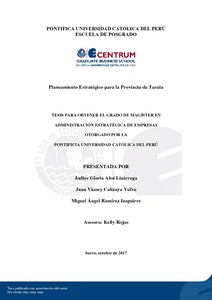| dc.contributor.advisor | Rojas Valdez, Kelly | |
| dc.contributor.author | Absi Lizárraga, Jadiye Gloria | es_ES |
| dc.contributor.author | Calizaya Yufra, Juan Vianey | es_ES |
| dc.contributor.author | Ramírez Izaguirre, Miguel Ángel | es_ES |
| dc.date.accessioned | 2017-11-02T17:40:35Z | |
| dc.date.available | 2017-11-02T17:40:35Z | |
| dc.date.created | 2017 | |
| dc.date.issued | 2017-11-02 | |
| dc.identifier.uri | http://hdl.handle.net/20.500.12404/9622 | |
| dc.description.abstract | La provincia de Tarata se encuentra localizada al sur del Perú, específicamente en la
región Tacna. Posee más de 7,000 habitantes, de los cuales solo la mitad ha culminado la
secundaria. La actividad económica más importante de la provincia es la agricultura,
destacando en la producción de orégano que no solo abastece el mercado local, sino que se
exporta. Adicionalmente, se desarrollan proyectos mineros y algunas actividades turísticas
incipientes.
De acuerdo al modelo establecido se elaboró el plan estratégico para el año 2030, con
lo cual la provincia de Tarata será totalmente autosostenible, manteniendo su liderazgo en la
producción del orégano, pero desarrollando a su vez otros cultivos. Esto irá de la mano con el
desarrollo del turismo vivencial, aprovechando la construcción de nuevas carreteras que
facilitarán el acceso, y se continuará promoviendo la inversión minera, siempre que se respete
el medio ambiente y no se presenten conflictos sociales.
Para lograr esto, se implementarán las siguientes estrategias retenidas, que resultaron
de un profundo análisis: (a) penetrar en el mercado de Brasil para la exportación de orégano,
(b) desarrollar servicios turísticos rurales y vivenciales de una manera competitiva y
sostenible en el tiempo; (c) penetrar en el mercado de Estados Unidos con el orégano, (d)
desarrollar servicio de acopio de orégano y otros productos agrícolas, tomando la
administración directa de la infraestructura; (e) desarrollar productos agroindustriales con
valor agregado; y (f) establecer plantas de generación eléctrica a partir de combustible fosil
en los distritos que aún no cuentan con este servicio. Además se establecieron cuatro
objetivos de largo plazo, de los cuales derivan 11 objetivos de corto plazo | es_ES |
| dc.description.abstract | The province of Tarata is located in the south of Peru, specifically in the Tacna
region. It has more than seven thousand inhabitants, of whom only half have completed
secondary school. The most important economic activity of the province is agriculture,
emphasizing in the production of oregano that not only supplies the local market, but it is
exported. In addition, mining projects and some incipient tourist activities are being
developed.
According to the established model, the strategic plan for the year 2030 was
elaborated, so that the province of Tarata will be totally self-sustaining, maintaining its
leadership in the production of oregano, but in turn developing other crops. This will go hand
in hand with the development of experiential tourism, taking advantage of the construction of
new roads that will facilitate access, and will continue to promote mining investment, as long
as the environment is respected and there are no social conflicts.
To achieve this, the following retained strategies will be implemented, which resulted
from an in-depth analysis: (a) penetrate the Brazilian market for the export of oregano, (b)
developing rural and experiential tourism services in a competitive and sustainable manner
over time; (c) to penetrate the US market with oregano, (d) to develop oregano and other
agricultural productions, taking direct management of infrastructure to build roads to attract
private investment in tourism, agriculture and mining, as well as facilitating the integration of
communities; (e) build potable water networks for disused districts and improve the quality
of life in marginal areas, and (f) develop value-added agroindustrial products; and (f)
establish power generation plants from fossil fuel in districts that do not yet have this service.
In addition, four long-term objectives were established, from which 11 short-term objectives
were derived | es_ES |
| dc.language.iso | spa | es_ES |
| dc.publisher | Pontificia Universidad Católica del Perú | es_ES |
| dc.rights | info:eu-repo/semantics/openAccess | es_ES |
| dc.rights.uri | http://creativecommons.org/licenses/by-nc-nd/2.5/pe/ | * |
| dc.subject | Planificación regional -- Perú -- Tacna | es_ES |
| dc.subject | Desarrollo regional -- Perú -- Tacna | es_ES |
| dc.subject | Planificación estratégica | es_ES |
| dc.title | Planeamiento estratégico para la Provincia de Tarata | es_ES |
| dc.type | info:eu-repo/semantics/masterThesis | es_ES |
| thesis.degree.name | Maestro en Administración Estratégica de Empresas | es_ES |
| thesis.degree.level | Maestría | es_ES |
| thesis.degree.grantor | Pontificia Universidad Católica del Perú. CENTRUM | es_ES |
| thesis.degree.discipline | Administración Estratégica de Empresas | es_ES |
| renati.discipline | 413307 | es_ES |
| renati.level | https://purl.org/pe-repo/renati/level#maestro | es_ES |
| renati.type | https://purl.org/pe-repo/renati/type#tesis | es_ES |
| dc.publisher.country | PE | es_ES |
| dc.subject.ocde | https://purl.org/pe-repo/ocde/ford#5.02.04 | es_ES |






